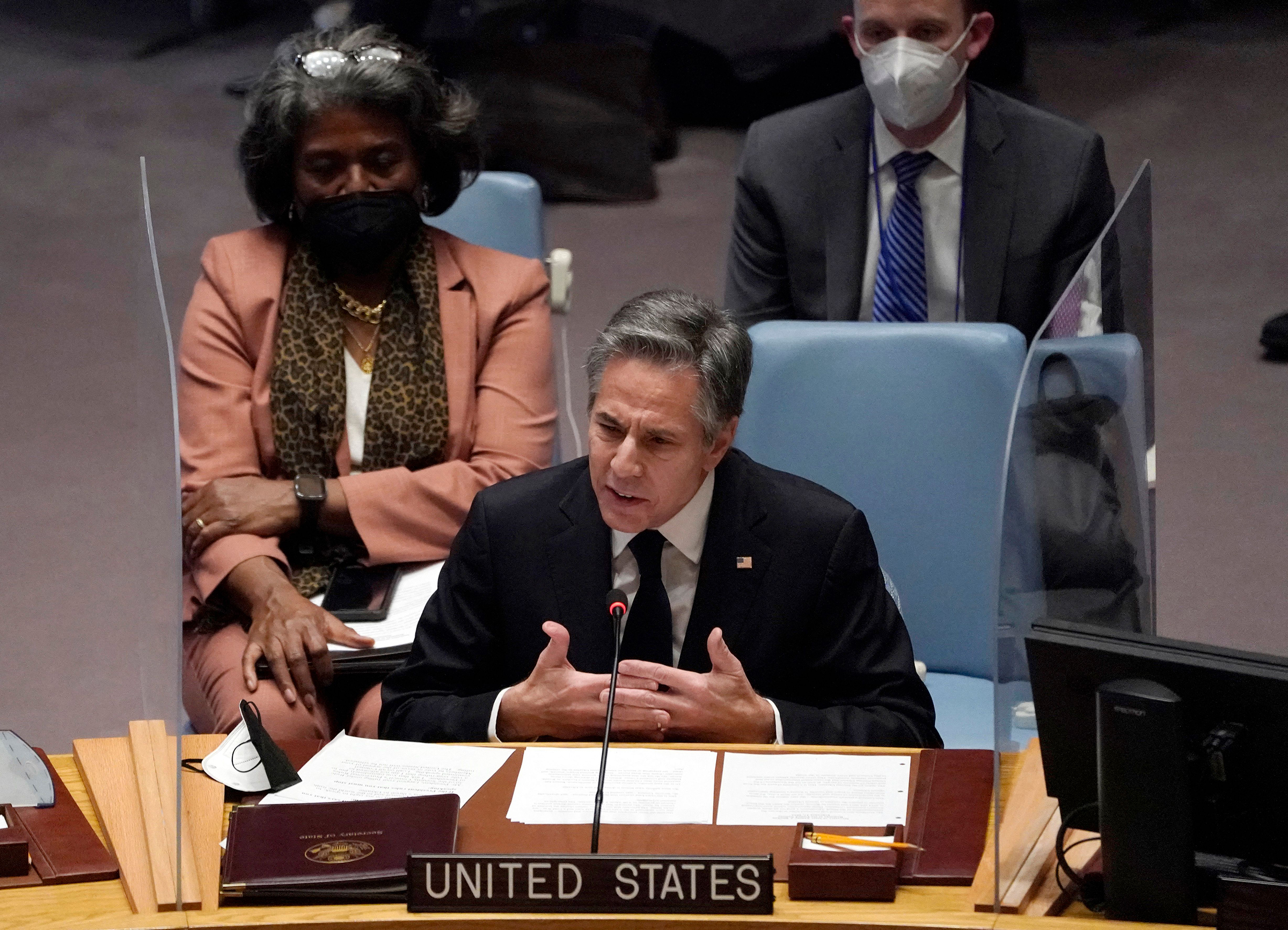Secretary of State Antony Blinken said Russia is moving toward an imminent invasion of Ukraine and laid out how U.S. intelligence believes such an operation will begin in the coming days, despite Moscow’s recent claims of reducing some of the 150,000 troops amassed along the Ukrainian border.
“Russia says it’s drawing down those forces,” Blinken said Thursday at the United Nations Security Council meeting in New York City. “We do not see that happening on the ground. Our information indicates clearly that these forces, including ground troops, aircraft, ships, are preparing to launch an attack against Ukraine in the coming days.”

Over the last 24 hours, the Russians have added additional troops, combat aircraft and even stored blood supplies at military field hospitals near the border in preparation for an operation, according to Biden Administration officials. Blinken laid out a nightmarish, multiple-staged scenario that U.S. intelligence believes Moscow intends to follow in the coming days to justify a military invasion of neighboring Ukraine. “We are laying it out in great detail, with the hope that by sharing what we know with the world, we can influence Russia to abandon the path of war and choose a different path while there’s still time,” Blinken said.
Under such a false-flag operation, he alleged Moscow will create a “fake” or “even a real chemical weapons attack” in Ukraine; then convene “emergency meetings” to address the so-called crisis; then issue proclamations that it must respond to defend ethnic Russians inside Ukraine; and ultimately launch an invasion that would lead all the way into the Ukrainian capital.
Blinken acknowledged that there would be criticisms of the U.S. decision to detail the possible Russian invasion scenario without supplying hard evidence. “I am here today not to start a war, but to prevent one,” he said. “The information I presented here is validated by what we’ve seen unfolding in plain sight before our eyes for months.”
Indeed. The internet is awash in satellite images, social media posts and other data that enable average citizens to access information that was once the domain of intelligence superpowers. Maxar Technologies, a private U.S. satellite imagery firm, published 23 photos on Monday that demonstrated increased Russian military activity around the Ukrainian borderlands—contrary to the troop draw-down that Moscow had claimed.
Blinken’s unscheduled appearance, which came just before he headed to a security conference in Munich, came among a flurry of escalations in the Ukraine crisis. On Thursday, the State Department said Russia expelled the U.S. Embassy’s second-ranking diplomat, Deputy Chief of Mission Bart Gorman, last week without cause. On Wednesday, the Pentagon said three U.S. Navy patrol aircraft “experienced unprofessional intercepts” over the weekend by Russian warplanes in mid-flight over the Mediterranean Sea in international airspace. Meanwhile, Ukraine- and Russian-backed separatists traded accusations of cease-fire violations.
The mounting number of international incidents prompted U.S. Ambassador to the United Nations Linda Thomas-Greenfield to ask Blinken to speak during the U.N. Security Council meeting before leaving for the Munich Security Conference. After laying out the U.S. case, Blinken called on Moscow to pull back its troops, tanks and planes from Ukraine’s borders to bases inside Russia and send “diplomats to the negotiating table” instead. Russian troops, tanks and artillery now surround Ukraine on all sides: in Belarus to the north, Russia to the east, Moldova to the west and Crimea, which Russia illegally seized from Ukraine in 2014, to the south.
Ben Hodges, a retired lieutenant general who once commanded all U.S. Army forces in Europe, said the combat power is now in place to give Russian President Vladimir Putin options. “But I believe, at the end of the day, that they really want to squeeze Ukraine, like a boa constrictor, until the economy and the government collapse,” he said.
The Biden Administration hopes diplomacy will lead the way in the deteriorating situation. But the lack of progress, and the continued build-up of Russian forces, has prompted the U.S. to draw up more aggressive strategies to deter Putin. In recent weeks, President Joe Biden has moved troops, naval ships and warplanes into eastern Europe, moved the embassy staff out of Kyiv and warned all Americans to leave Ukraine immediately.
Since the Russian troop buildup began late last year, Putin has maintained that his forces do not intend to move on Ukraine, but he remains concerned over the North Atlantic Treaty Organization’s (NATO) military expansion along its borders in recent decades. So, what does he want? On Thursday, Russian diplomats handed their American counterparts a set of responses for further dialogue on a range of issues of mutual concern, including missile deployments in Europe, increased mutual disclosure on military drills and other topics.
Russia stipulated, however, that for those diplomatic talks to move forward, NATO must cease its eastward expansion and end the U.S. military’s ties with Ukraine and other former Soviet nations—concessions the U.S. has already dismissed as non-starters. “Essentially the response was, ‘We won’t start negotiating on these individual items—you need to accept our ultimatums first,’” said Rose Gottemoeller, former deputy secretary general of NATO and a long-time U.S. diplomat. “So once again, it doesn’t look like Putin wants to negotiate, he’s just playing with us.”
More Must-Reads from TIME
- Caitlin Clark Is TIME's 2024 Athlete of the Year
- Where Trump 2.0 Will Differ From 1.0
- Is Intermittent Fasting Good or Bad for You?
- The 100 Must-Read Books of 2024
- Column: If Optimism Feels Ridiculous Now, Try Hope
- The Future of Climate Action Is Trade Policy
- FX’s Say Nothing Is the Must-Watch Political Thriller of 2024
- Merle Bombardieri Is Helping People Make the Baby Decision
Write to W.J. Hennigan at william.hennigan@time.com